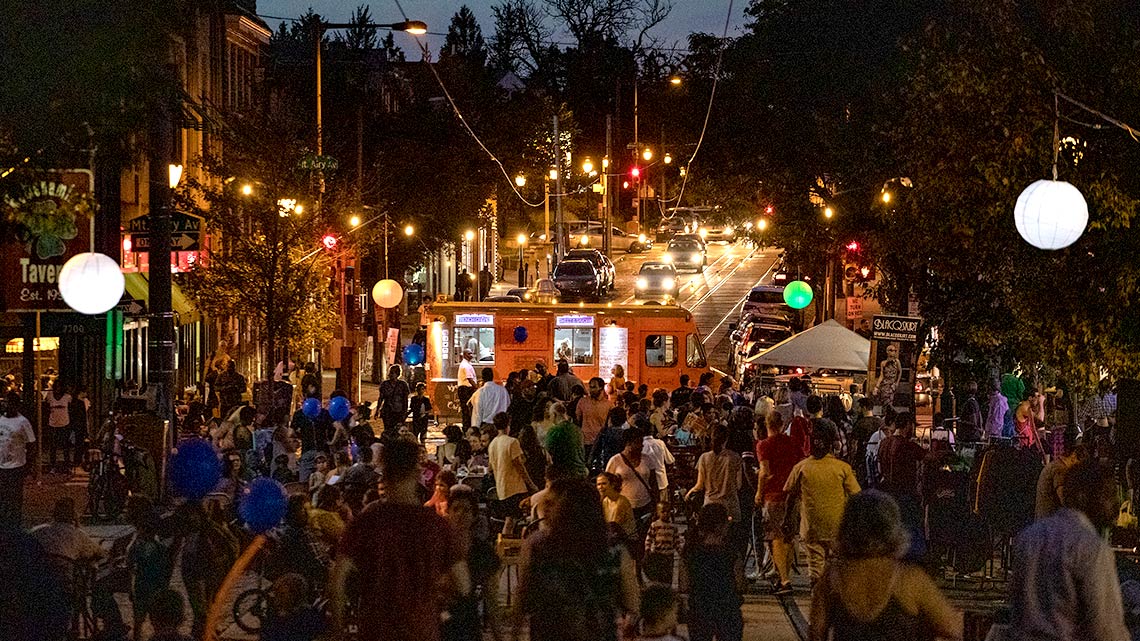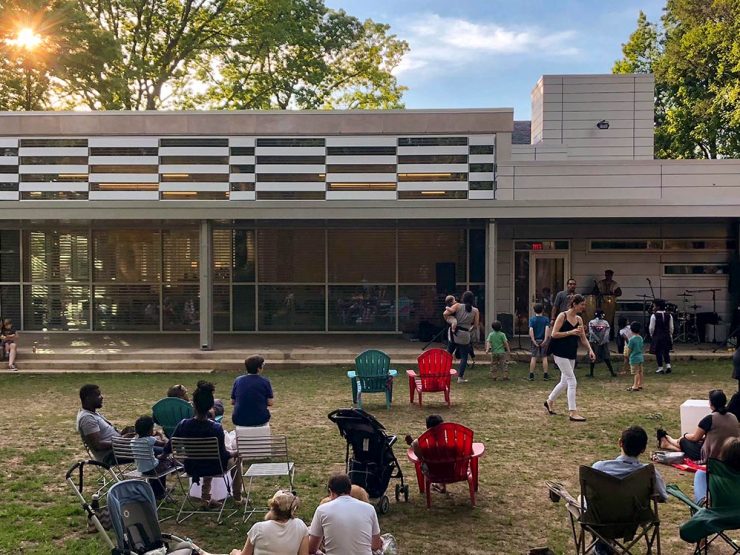Explore Mt. Airy
Visit Mt. Airy
Welcome to Mt. Airy! Our neighborhood has much to explore—food, drink, history, culture, shopping, and the beautiful Wissahickon. Mt. Airy is also distinguished for its history of racial diversity and integration.
Learn more about Mt. Airy history.
GETTING HERE
Mt. Airy is served by two SEPTA Regional Rail lines. The Chestnut Hill East Line stops at the Mount Airy, Sedgwick, Stenton and Washington Lane stations in East Mt. Airy. The Chestnut Hill West line stops at Allen Lane, Carpenter, Upsal and Tulpehocken stations in West Mt. Airy. The 23 bus route originates on Locust Street in Center City and travels up 11th Street to Germantown Avenue, passing through Germantown, Mt. Airy, and Chestnut Hill.
Free parking is available in a municipal lot on Germantown Ave. between FitLife and Rothe Florists, and paid parking can be found on the street and paid for via the ParkMobile app.
ARCHITECTURE

Mt. Airy is named after the summer estate belonging to prominent merchant and Chief Justice of Pennsylvania William Allen, who built his mansion on Germantown Avenue in 1750 (where Lutheran Theological Seminary now stands). The area was a summer resort for wealthy Philadelphians who wanted to escape the city and find fresh air among the hills.
Today the neighborhood is known for its varied and beautiful architecture, built mostly in the late 19th and early 20th centuries. Local nonprofit Mt. Airy Learning Tree offers seasonal walking tours, including of the Tourison-built homes in East Mt. Airy.
In 1904, Ashton Tourison, Sr. purchased 125 acres between Chew and Stenton Avenues to create Sedgwick Farms: “stone-built homes, planned on an architectural idea that makes each different from the other, yet in perfect harmony with all.”
Mt. Airy on the whole features large gray-stone homes (many made of Wissahickon schist quarried nearby) in Victorian, colonial revival, and Cotswold style. These homes dominate in districts like West Mount Airy’s Pelham section (a Wendell and Smith development from the 1890s), East Mount Airy’s Gowen Avenue (the James Gowen Estate development from the 1880s), Sedgwick Farms mentioned above, and Stenton (a Frank Mauran development from 1905) areas. Meanwhile, the stunning French Village homes of Elbow Lane, Gate Lane, and Allens Lane replicate the French Normandy style. (Credit: Wikipedia)
Read more about the neighborhood’s architecture:
Local Author Regales Mt. Airy Residents with History Behind the Neighborhood’s Architecture
CULTURAL VENUES

Sedgwick Theater – The historic Sedgwick Theater was built in 1928 as an Art Deco movie palace designed by William Lee. Alex Burns, director of the theater’s resident company, Quintessence Theatre Group, has toured London, Paris and New York. This repertory theater brings classic drama and literature to the contemporary stage. In 2024, renovations will begin to restore the Art Deco marquee to its original glory.
Allens Lane Art Center – Since its founding in 1953, Allens Lane Art Center has been a cornerstone of the Mt. Airy community, bringing residents together to participate in and experience the arts. Whether it’s art classes for children or adults, art exhibitions, or cutting-edge plays on the main stage, there is something for everyone at Allens Lane.
Philadelphia School of Circus Arts – PSCA is a recreational program featuring the largest variety of circus classes, equipment, and disciplines in the region for students of all backgrounds – from age 2 and up. They share space with sibling circus organizations on a beautiful historic campus on Greene Street that was once a Catholic church and school.
Lantern Theater Company – A second location of the popular Center City-based Lantern Theater is coming to Germantown Ave. & Mt. Pleasant in 2024!
WISSAHICKON VALLEY PARK

Looking for a taste of nature in the City of Brotherly Love? Look no farther than the Wissahickon, a pristine 1,800-acre park less than 10 miles from Center City. Whether you are a walker, hiker, biker, or horseback rider, the wooded paths of the Wissahickon will have you breathing fresh air and marveling that you’re still within city limits.
In 1868, the seven-mile stretch of the Wissahickon was acquired by Fairmount Park to protect the city’s water supply. The turnpike that ran alongside Wissahickon Creek was closed to cars in 1920, earning it the eerie name Forbidden Drive. Today it is the main, lovely thoroughfare through the park, with several points of interest and more rugged trails accessible along the way. Friends of the Wissahickon is the organization responsible for care of the 1,800-acre park: www.fow.org.
A Few Highlights
The only historic roadhouse of the Wissahickon Valley still in the operation, the picturesque Valley Green Inn hosts weddings beside the creek and houses a restaurant and snack bar. Time your excursion to arrive for brunch or lunch. Valley Green Rd., 215.247.1730, www.valleygreeninn.com.
A fascinating sculptural installation by artist Jody Pinto can be found deep in the woods along the orange trail. Resembling a human finger, Fingerspan serves as a pedestrian bridge across a dramatic gorge as well as a man-made curiosity within a wholly natural setting. Trail access from Livezey Lane.
The Wissahickon Environmental Center stands at the northern end of the park and welcomes visitors with seasonal programming, including maple sugaring in February and apple cider making in October. 300 W. Northwestern Ave., 215-685-9285, www.fow.org.
SHOPPING & DINING
Find more information about our local small businesses, shopping, and dining in Mt. Airy – including the Crafting Renaissance we are experiencing!


 Upcoming Events & Workshops
Upcoming Events & Workshops Go Mt. Airy Business Directory
Go Mt. Airy Business Directory Lovett Library & Park
Lovett Library & Park